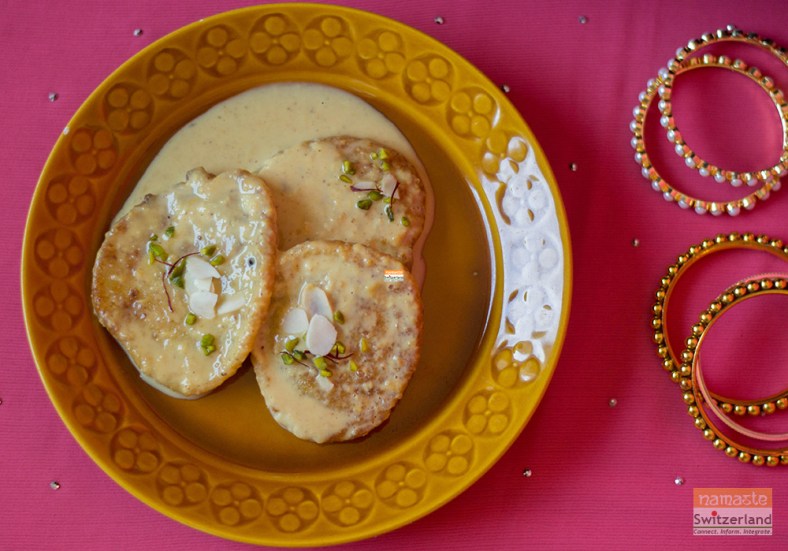
I grew up in the coastal state of Goa, where we lived in government staff quarters in a multi-cultural community. Festivals from every part of the country, from Diwali to Ganesh Chaturti to Onam were celebrated with equal aplomb. But Holi, now Holi was special! The lure of colours, walking the colony lanes with coloured powder in our hands, siphoning water from the neighbour’s water tanks, being pelted with water balloons, retorting with ‘pichkaris’ (water pistons) ….there was excitement and energy all around.
There was a jaunty, high-spirited gentleman, our colony’s self-appointed Holi-in-charge, who would have spent days making the perfect Bollywood playlist on his cassette tapes, and then setting up speakers and a music system in his parking lot. Come Holi, and everyone would dance to the tunes of ‘Rang Barse’, some under the influence of ‘bhaang’, others just high on life!
What I remember most vividly, and very fondly, from the Holi of my childhood was the food. As a family hailing from the South of India, a region where Holi is not commonplace, we were not used to cooking up Holi treats at home. But what we lacked for in Holi delicacies, our neighbours from the North more than made up for. Our lovely Punjabi neighbours would come bearing plates with hot ‘kachoris’ (deep fried savoury snacks), fresh from the ‘kadhai’ (wok), my father’s colleague would drop by with ‘gujias’ (deep fried sweet pastry) from a local sweet shop and I would get my fill of the wonderfully cooling ‘thandai’ (cooling milk-based drink) from yet another benevolent neighbour. It was during Holi that I first tasted malpua, served with rabdi.

A quintessential celebration dessert, malpua with rabdi is a pairing made in dessert heaven. Malpua is a deep-fried pancake with a hint of fennel, its flavour enhanced by soaking in a saffron-flavoured sugar syrup. It is then served warm with a topping of rabdi and a light garnish of nuts.
This Holi, try this easy-to-follow recipe, and be transported to a Holi celebration in India. Most of the ingredients used here are available in local supermarkets, and some, such as saffron and ‘khoya’ are available at local Indian stores.
Begin with preparing the rabdi, which will be served with the malpua once done. Rabdi, or thickened sweetened milk, is traditionally made by reducing full-fat milk with sugar, simmering it gently on medium heat. The layers of cream that are produced in the process are added back to the milk, giving it a rich, thick consistency. The recipe I have shared is a quicker way of preparing rabdi, using store-bought condensed milk in addition to full-fat milk and sugar.
For the rabdi:
1 liter full-fat milk
250 ml sweetened condensed milk
1tsp cardamom powder
A few strands of saffron
In a heavy bottom vessel, heat the milk, let it come to a boil and continue to heat until it is reduced to around half its volume (this should take around 20 minutes). Add the condensed milk and stir it well. Continue to cook on low to medium heat, stirring regularly to ensure the bottom of the pan doesn’t burn. Add the saffron strands and cardamom powder. Cook for another 10 to 15 minutes on low heat. The milk-condensed milk mixture should be reduced to a creamy consistency. Let the mixture cool, and garnish it with slivered almonds and pistachios.
Once the rabdi is done, prepare the sugar syrup that will be used to soak the malpuas. This sugar syrup can be used in other Indian desserts such as ‘gulab jamuns’, ‘jalebis’ too!
For the Sugar Syrup:
2 cups granulated sugar
2 cups water
A few strands of saffron
Seeds of 3 green cardamom pods
Using a mortar and pestle, lightly crush the cardamom pods and keep them aside. In a heavy-bottom vessel with high sides, add the water and sugar. Heat the vessel on medium heat and stir the contents. Let this sugar solution come to a boil. Once it begins boiling, add the cardamom seeds and the strands of saffron. Continue cooking, and let the syrup thicken. Turn off the heat after around 10 minutes.
For the Malpua:
100gms khoya (‘khoya’ or ‘mawa’ is made from dried milk solids and is a common ingredient in Indian desserts)
1 cup of all-purpose flour
Warm water for kneading the dough
1/2 teaspoon baking powder
1/2 teaspoon fennel seeds
Vegetable oil to deep fry the malpua
Grate the khoya and transfer it to a bowl. Add the flour and mix it with the grated khoya. To this mixture, add the baking powder and fennel seeds.
Add warm water a little at a time, stirring after each addition. The batter should be of a pourable consistency (similar to a pancake batter). Using a whisk, gently beat the batter. This ensures that the malpua is fluffier.
In a pan, pour in some oil (or ghee) just enough to cover the malpua, and not completely immerse it. Heat the oil on medium heat, and using a ladle, pour in the malpua batter. The batter will take the shape of a pancake, and spread on its own. Flip over the malpua after a minute, such that it is evenly cooked on both sides, and is golden brown. Take out the malpua and drain on a paper towel. Continue frying malpuas, one at a time.
Once done, soak the malpuas in the prepared sugar syrup, letting them sit in the sugar syrup for around 2 minutes.

Serve the malpua with the rabdi, and enjoy!
Disclaimer: Opinions and methods expressed are solely of the writer. Namaste Switzerland does not undertake any obligation or liability which may arise from the content.











